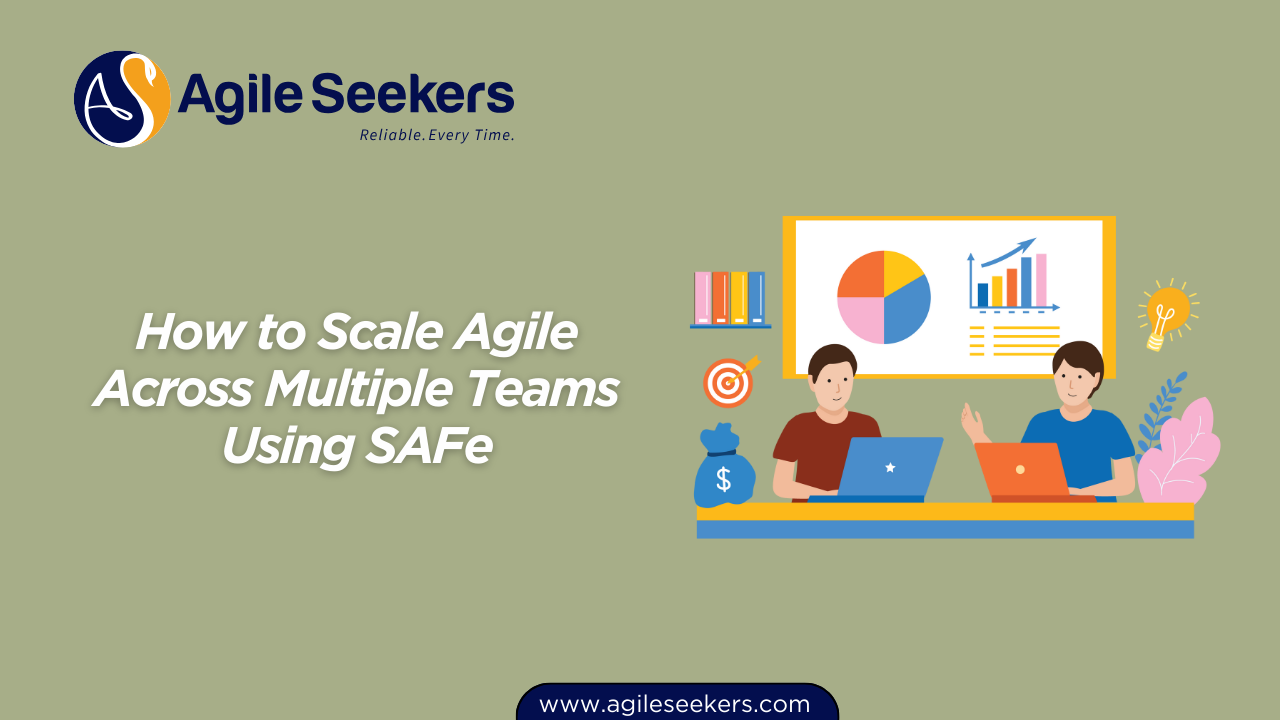How to Scale Agile Across Multiple Teams Using SAFe

Here’s the thing: Most organizations struggle with scaling because what works for one team doesn’t translate directly to ten, twenty, or more teams. Communication breaks down. Teams bump into each other. Priorities get fuzzy.
SAFe addresses these pain points by providing structure, clear roles, and a cadence for collaboration at scale. It lets you keep your teams Agile, but brings them together under a common strategy and roadmap.
Step 1: Start With Leadership Buy-in and a Clear Vision
Scaling Agile isn’t just a bottom-up movement. Leadership must own the transformation. Leaders set the vision, align funding, and break down silos.
If you’re serious about scaling, your first step should be investing in a core group of trained change agents. Think of them as your internal consultants—the folks who will guide, coach, and challenge the organization.
-
Want to train your leaders? Check out Leading SAFe Agilist Certification Training. This program builds the foundational knowledge leaders need to champion SAFe.
Step 2: Organize Around Value, Not Just Projects
Traditional org charts are great for reporting lines, but they’re lousy for delivering value fast. SAFe flips the script by organizing teams into Agile Release Trains (ARTs).
An ART is a long-lived team of Agile teams (usually 50–125 people) aligned to a value stream—essentially a chunk of your business that delivers value to customers.
-
If you’re unsure how to map value streams or design ARTs, dig into external resources like the Scaled Agile Value Streams Overview for more detail.
Step 3: Build and Launch Your Agile Release Trains (ARTs)
Here’s where theory meets action. To launch an ART, you:
-
Identify which teams, systems, and business owners are part of the value stream.
-
Train everyone—not just leaders—on the principles of Agile and SAFe.
-
Establish roles like Release Train Engineer (RTE), Product Owner, Product Manager, Scrum Master, and System Architect.
Every team member should understand their place on the train. If you’re serious about setting up strong product roles, the SAFe Product Owner Product Manager POPM Certification is your go-to.
Step 4: Align Teams with a Shared Cadence and Planning Rhythm
One of the core strengths of SAFe is synchronizing the work of multiple teams.
Instead of everyone running on different cycles, you bring teams together for Program Increment (PI) Planning. This is a face-to-face (or virtual) event where all teams align on what they’ll deliver over the next 8–12 weeks.
PI Planning is a game changer:
-
Dependencies become visible.
-
Priorities get hammered out in real time.
-
Teams can commit to shared objectives.
Want to see how Scrum Masters can lead this process? SAFe Scrum Master Certification will get your facilitators ready for PI Planning and more.
Step 5: Make Roles and Responsibilities Crystal Clear
Scaling introduces new roles that don’t exist in basic Scrum. You need clarity on:
-
Release Train Engineer (RTE): Think of this person as the chief Scrum Master for the ART. They steer the train, remove roadblocks, and help teams deliver together. The SAFe Release Train Engineer Certification Training gives you the tools to excel in this pivotal role.
-
System Architect: Ensures technical alignment and system thinking across teams.
-
Product Management: Owns the ART backlog, sets priorities, and makes the big calls.
When everyone knows their lane, the train moves faster.
Step 6: Foster Relentless Improvement
Scaling is not a “set it and forget it” exercise. You need built-in feedback loops at every level:
-
System demos at the end of every iteration and PI
-
Inspect and adapt workshops for ARTs to address systemic problems
-
Metrics that look beyond velocity—think customer satisfaction, time-to-market, and defect trends
For advanced facilitation and driving continuous improvement, your leaders can level up with SAFe Advanced Scrum Master Certification Training.
Step 7: Manage Dependencies and Risks Proactively
With multiple teams running in parallel, cross-team dependencies and risks can tank progress.
SAFe introduces Program Boards, scrum-of-scrums, and risk management sessions so nothing slips through the cracks.
-
Regular sync meetings between Scrum Masters and RTEs
-
Transparent visualization of dependencies
-
Real-time escalation of risks, not weeks later
It’s worth reviewing Agile Release Train Best Practices for proven tactics on ART coordination.
Step 8: Build a Culture of Collaboration and Learning
Scaling Agile isn’t just about process. It’s a mindset shift. Teams need psychological safety to experiment, fail, and learn.
Host Communities of Practice for roles (Scrum Masters, Architects, Product Owners). Encourage job shadowing, workshops, and knowledge sharing. Make learning part of the job, not an afterthought.
Common Pitfalls (And How to Dodge Them)
Let’s be honest—most organizations stumble at least once during scaling. Here are a few classic traps:
-
Copy-pasting frameworks: Don’t turn SAFe into a checklist. Adapt it to your context.
-
Forgetting the “why”: Scaling Agile should deliver better business outcomes, not just “do Agile at scale.”
-
Skipping training: Untrained teams won’t get the benefits. Invest in building real SAFe capabilities at every level.
The Bottom Line
Scaling Agile with SAFe isn’t about making everyone follow the same playbook. It’s about connecting teams to strategy, amplifying collaboration, and building feedback loops that span the whole organization.
Yes, it takes effort and investment. But if you get leadership engaged, organize around value, invest in training, and focus on continuous improvement, you’ll see tangible results—faster delivery, better alignment, and a culture that’s built for change.
If you’re ready to scale, start with the right foundation. Check out the training options above to equip your teams and leaders for success.
Quick Recap of Useful Resources and Certification Links:
Also read - Measuring Progress During Your SAFe Journey
Also see - How to Run an Effective Inspect and Adapt Workshop in SAFe




















